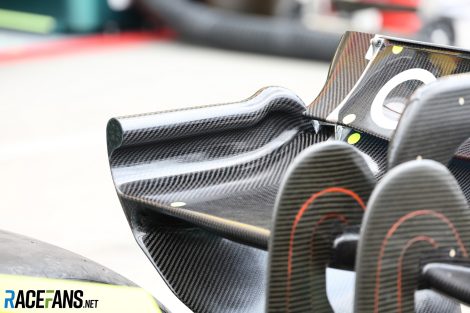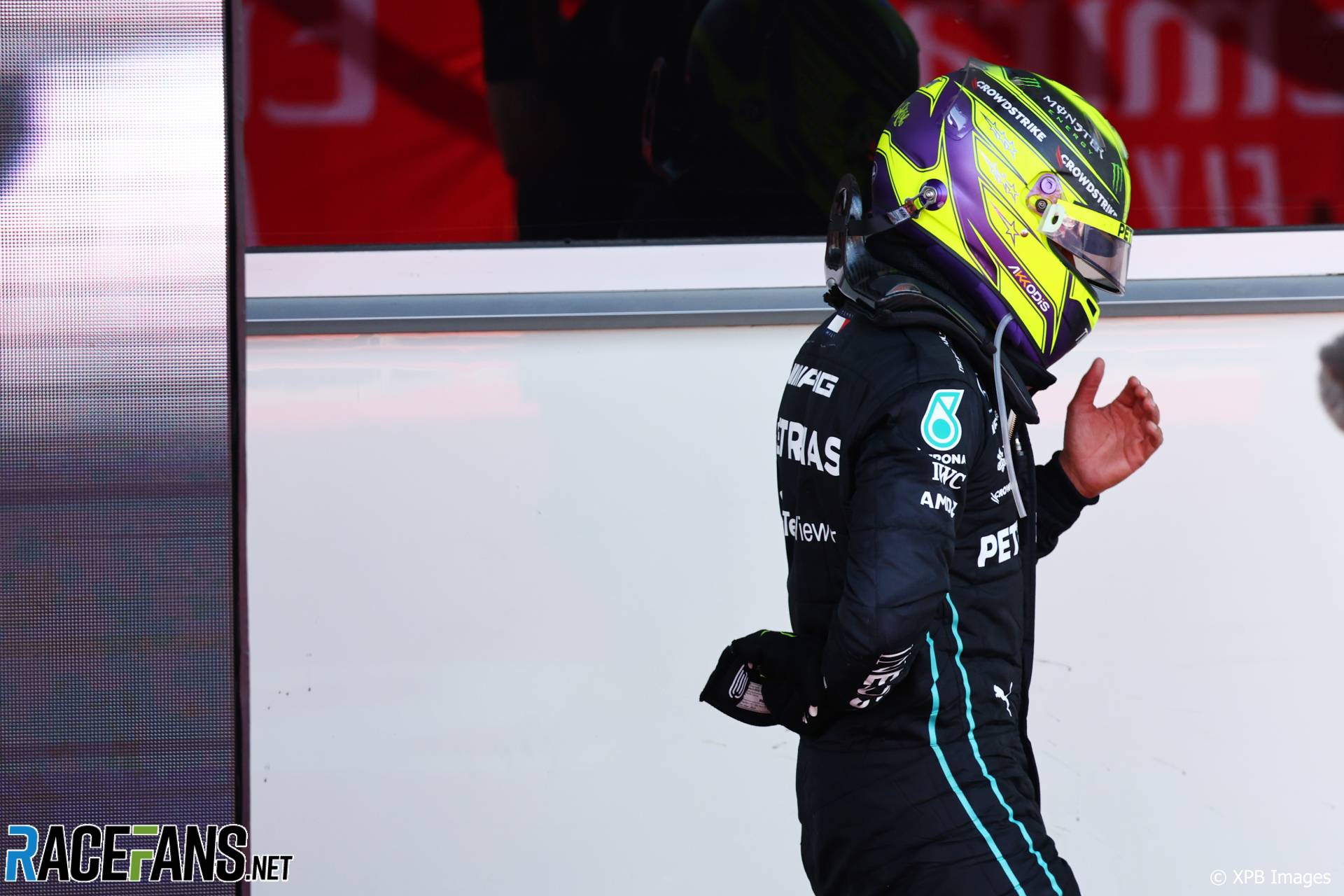Formula 1’s chief technical officer Pat Symonds believes the sport’s governing body went too far in its bid to reduce ‘porpoising’ after the Azerbaijan Grand Prix.
The FIA introduced a series of rules changes in response to the punishment some drivers suffered from the bouncing their cars experienced following the introduction of heavily revised regulations this year. Lewis Hamilton in particular was visibly pained by the rough ride he endured at the Baku City Circuit.A new metric limiting how much cars may bounce was introduced by the FIA. For 2023 the physical dimensions of the cars’ floors is being changed in an effort to reduced the ‘porpoising’ phenomenon. But Symonds believes the changes go too far.
“I think they overreacted a bit after Baku,” he told Auto Motor und Sport. “In Baku we saw the worst impact because a team tried something that didn’t work and then went public quite loudly.
“Had they not intervened, the problem would have been solved. Most teams now understand how to control bouncing.”
As the season progressed teams such as Mercedes increasingly mastered their porpoising problems. However it remained a factor at some circuits, including Yas Marina, scene of the season finale.
Symonds, who has decades of experience as an F1 engineer, admitted he had failed to anticipate the problem when he and his team drew up the ground effect rules which the FIA introduced in 2022.
“I have to admit, it wasn’t on our radar,” he said. “But we should have had [foreseen] it.
“We had the ability to discover it beforehand because we worked with dynamic simulations. For example, we used them to check what happens when a car spins and gets air under it. So the type of accident that Mark Webber once had in Valencia. This requires special software that we could have used to anticipate and understand the bouncing.
Advert | Become a RaceFans supporter and
“I should have known too, because I used to work on ground effect cars. I had simply forgotten. Without a doubt, bouncing changed things. The teams first had to solve this problem before they could work on their aerodynamics. Bouncing is not purely an aerodynamic problem. A lot of mechanics also play a role, for example the suspension stiffness.”

“We couldn’t see anything on the cars that would have damaged our concept,” he said. “A few things were definitely more radical than we thought.
“For example the Mercedes. We later tested and reviewed the concept in CFD and I have to say that the shape of the Mercedes is easier to follow than the other cars.
“The Aston Martin rear wing was also something we didn’t expect. I see a risk in this idea that it could go the wrong way if the idea is pursued further and pushed to the limit. I expect the FIA will ban that for 2023.”
F1’s biggest teams enjoyed the most success under the new rules. Only a single podium for McLaren’s Lando Norris at Imola prevented Red Bull, Ferrari and Mercedes from sweeping the rostrum places across 2022.
Symonds admitted the completion wasn’t as close as he expected under the new rules but is hopeful that will change next year. “We underestimated that some teams still have large aerodynamics departments that got more out of the new rules,” he said.
“But we are hopeful that the gap from front to back will narrow quickly. This could already be observed to a small extent during the season.”
Advert | Become a RaceFans supporter and
2022 F1 season
- Mercedes told me “you’re wrong” about 2022 car’s problems – Hamilton
- FIA confirms all 10 F1 teams complied with 2022 cost cap
- Steiner “not ashamed” of panning “slow” Schumacher in Drive to Survive
- Albon believes year out of F1 improved him as a driver
- Hamilton sees diversity gains in F1 years on from his ‘traumatising’ experience of racism





Armchair Expert (@armchairexpert)
29th December 2022, 7:34
Great acting though, truly Oscar-worthy.
Mayrton
29th December 2022, 8:00
Similar to the in season tire change in 2021. They cracked under Toto Wolffs ‘safety issue’ pressure twice now. Safety is a valuable card.
Leeroy (@leeroy)
30th December 2022, 13:22
The Mercedes drivers were told to put on a show by Toto, “act up the pain”. FIA fell for it. The change to the cars next season suits Mercedes and hurts smaller teams who now have to start over again with aero..
SjaakFoo (@sjaakfoo)
29th December 2022, 8:42
This is what happens once you go down the road of mid-season rule changes on the regular.
Rule changes should be sparse, well researched, and done only between seasons. Unless there’s an immediate risk to life, which also has to be proven beyond one driver acting like his back has died until magically fixed five days later through pseudo-science.
Hardly the only example of this in recent times, at that, it’s a dumb way to run a sport. In this case they had examples of teams that had already overcome the porpoising problem at the time they decided to make the change, too. There really was no reason for it at that point.
Itsmeagain (@)
29th December 2022, 10:07
Some folks call this conspiracy…. I would call it stakeholdermanagement the way Toto does from the beginning
Mayrton
29th December 2022, 12:04
and is one of the best at it.
Proesterchen (@proesterchen)
29th December 2022, 10:39
But Pat, (2) drivers were getting hurt and it was so dangerous they could hardly see the walls they managed not to crash into once the whole weekend!
MG1982 (@mg1982)
29th December 2022, 15:17
Raise the car, soften the suspension, change the car…. ban the car for Christ sake!
RaverX
30th December 2022, 2:40
Correct.
Stephen Crowsen (@drycrust)
30th December 2022, 19:20
Exactly right! It was obvious some team management were punishing the drivers for trying to drive the car as fast as it can go. There was even one team principal who said drivers just complain about these things. When I was a bus driver I’d heard similar arguments for years “We don’t know how to fix this problem”, but then as soon as the union got the rules changed so drivers got paid extra because of that problem then the problem was solved. Pat should know better than to say this sort of wishy-washy stuff. Bringing in Fines was exactly the right thing to do! The team is responsible for making sure the car is safe to drive at the fastest speed they expect it to go on the race track. The team’s accountants don’t want to be paying fines for what they’d see as inept design. If car performance suffered making the car safe to drive at the fastest speed on that track then that isn’t the driver’s problem, nor is it the accountant’s problem, it is the responsibility of the designers and engineers to fix it.
S
29th December 2022, 11:44
The FIA often overreact to the desires of the big teams, while simultaneously under-reacting the the needs of the small ones.
BlueChris (@bluechris)
29th December 2022, 18:48
Toto enters the chat smiling